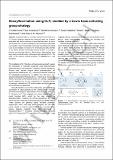Files in this item
Deoxyfluorination using CuF2 : enabled by a Lewis base activating group strategy
Item metadata
| dc.contributor.author | Sood, D. Eilidh | |
| dc.contributor.author | Champion, Sue | |
| dc.contributor.author | Dawson, Daniel M. | |
| dc.contributor.author | Chabbra, Sonia | |
| dc.contributor.author | Bode, Bela E. | |
| dc.contributor.author | Sutherland, Andrew C. | |
| dc.contributor.author | Watson, Allan John Bell | |
| dc.date.accessioned | 2021-03-18T00:40:12Z | |
| dc.date.available | 2021-03-18T00:40:12Z | |
| dc.date.issued | 2020-05-18 | |
| dc.identifier | 266887061 | |
| dc.identifier | 1c251a60-46b0-4ba2-9bca-c4e78be59a3f | |
| dc.identifier | 85082827261 | |
| dc.identifier | 000520275500001 | |
| dc.identifier.citation | Sood , D E , Champion , S , Dawson , D M , Chabbra , S , Bode , B E , Sutherland , A C & Watson , A J B 2020 , ' Deoxyfluorination using CuF 2 : enabled by a Lewis base activating group strategy ' , Angewandte Chemie International Edition , vol. 55 , no. 22 , pp. 8460-8463 . https://doi.org/10.1002/anie.202001015 | en |
| dc.identifier.issn | 1433-7851 | |
| dc.identifier.other | ORCID: /0000-0002-1582-4286/work/70619095 | |
| dc.identifier.other | ORCID: /0000-0002-8110-4535/work/70919897 | |
| dc.identifier.other | ORCID: /0000-0002-3384-271X/work/70919910 | |
| dc.identifier.uri | https://hdl.handle.net/10023/21652 | |
| dc.description | We thank the University of St Andrews for PhD studentships (D.E.S and S.C.), GlaxoSmithKline and the University of Glasgow for financial support. | en |
| dc.description.abstract | Deoxyfluorination is a primary method for the formation of C–F bonds. Bespoke reagents are commonly used due to issues associated with the low reactivity of metal fluorides. Here, we report the development of a simple strategy for deoxyfluorination using first‐row transition metal fluorides that overcomes these limitations. Using CuF2 as an exemplar, activation of an O ‐alkylisourea adduct formed in situ allows effective nucleophilic fluoride transfer to a range of primary and secondary alcohols. Spectroscopic investigations have been used to probe the origin of the enhanced reactivity of CuF2 . The utility of the process towards enabling 18F‐radiolabeling is also presented. | |
| dc.format.extent | 577539 | |
| dc.language.iso | eng | |
| dc.relation.ispartof | Angewandte Chemie International Edition | en |
| dc.subject | Copper | en |
| dc.subject | Deoxyfluorination | en |
| dc.subject | Fluorine | en |
| dc.subject | PET | en |
| dc.subject | Radiolabeling | en |
| dc.subject | Alcohols | en |
| dc.subject | Synthetic methods | en |
| dc.subject | QD Chemistry | en |
| dc.subject | NDAS | en |
| dc.subject.lcc | QD | en |
| dc.title | Deoxyfluorination using CuF2 : enabled by a Lewis base activating group strategy | en |
| dc.type | Journal article | en |
| dc.contributor.institution | University of St Andrews. EaSTCHEM | en |
| dc.contributor.institution | University of St Andrews. School of Chemistry | en |
| dc.contributor.institution | University of St Andrews. Sir James Mackenzie Institute for Early Diagnosis | en |
| dc.contributor.institution | University of St Andrews. Biomedical Sciences Research Complex | en |
| dc.contributor.institution | University of St Andrews. Centre of Magnetic Resonance | en |
| dc.identifier.doi | https://doi.org/10.1002/anie.202001015 | |
| dc.description.status | Peer reviewed | en |
| dc.date.embargoedUntil | 2021-03-18 |
This item appears in the following Collection(s)
Items in the St Andrews Research Repository are protected by copyright, with all rights reserved, unless otherwise indicated.

